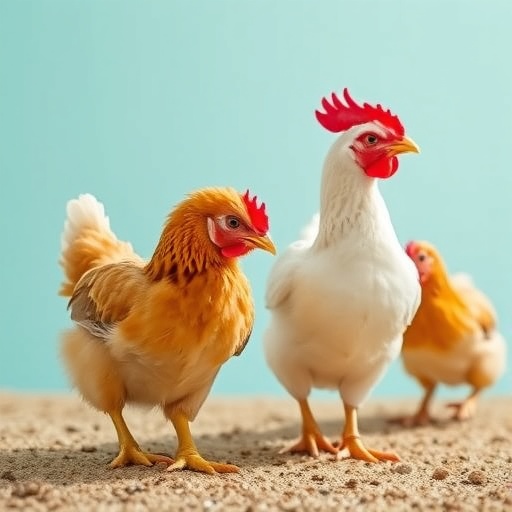In a groundbreaking study published in 2025, researchers unveiled the remarkable genetic factors influencing egg weight in chickens, which has crucial implications for poultry production and genetic research. The study authored by Wang, Han, Fan, and their colleagues focuses on a specific genetic duplication downstream of the GATA6 gene, revealing a striking 17.1 kilobase pair (kb) segment associated with significant variations in egg weight. This new insight not only enriches our understanding of avian genetics but also sets the stage for potential advancements in the agricultural sector.
The GATA6 gene, central to this study, encodes a transcription factor that plays a vital role in various biological processes, including cell differentiation and organ development. While previous research had hinted at the gene’s involvement in reproductive traits, this study methodically explores the relationship between the downstream genetic duplication and egg weight. Egg weight is a critical factor in poultry farming, with direct implications for economic viability and productivity. The intricate relationship between genotype and phenotype in avians has long intrigued geneticists, and this study adds another dimension to our understanding.
Wang and colleagues meticulously collected data from a diverse population of chickens, aiming to provide a comprehensive analysis of genetic variance. By implementing high-throughput sequencing technologies, the researchers were able to identify the duplication event and its size, narrowing down the associated genetic mechanisms. Their findings demonstrate that the identified 17.1 kb duplication appears to influence the expression levels of GATA6, ultimately affecting egg production metrics.
The implications of this research extend beyond academic curiosity; they could revolutionize the poultry industry. In a world increasingly focused on sustainable agricultural practices, understanding the genetic underpinnings of desirable traits can lead to more efficient breeding programs. By leveraging genetic information, breeders can select chickens that carry favorable traits, such as enhanced egg weight, ensuring better outcomes for both farmers and consumers.
Intriguingly, the study highlights a correlation between the genetic duplication and increased egg weight, proposing a theoretical model that elucidates this relationship. The duplication enhances the transcriptional activity of GATA6, leading to upregulated genes essential for oocyte development and ovogenesis. The intricate biological pathways affected by this mechanism are a focal point for future research, as scientists strive to decode the complex network of genes that regulate reproductive traits in avians.
As global populations continue to rise, the demand for poultry products, particularly eggs, is increasing exponentially. The findings of this research hold the potential to meet this demand sustainably. By integrating genetic advancements with traditional breeding practices, poultry producers can enhance productivity while reducing the environmental footprint of egg production.
Moreover, the methodologies employed in this study offer a blueprint for future genetic research in both avian species and other livestock. The use of advanced genomic techniques highlights the importance of precision agriculture, where data-driven decisions guide breeding programs aimed at maximizing yield and efficiency. This intersection of genetics and agriculture marks a new frontier in food security efforts globally.
The researchers also call attention to the potential ethical dimensions of genetic interventions in agriculture. While the quest for increased productivity is essential, it must be balanced with considerations of animal welfare and biodiversity. As such, the findings should serve as a catalyst for a broader dialogue regarding the appropriate use of genetic technologies in agriculture.
In summary, this research unpacks a significant genetic finding that could reshape our understanding of egg production in chickens. The identification of the 17.1 kb duplication downstream of GATA6 not only elucidates its role in enhancing egg weight but also exemplifies the broader potential of genetic research in addressing pressing agricultural challenges. As studies like these progress, consumers and producers alike will need to engage in discussions about the future of food production and the role of genetic advancements in creating sustainable agricultural systems.
This study, while primarily focused on one trait in chickens, opens up avenues for exploring similar genetic mechanisms in other species. The study of gene duplications and their effects on phenotypic traits could lead to a treasure trove of information that future researchers can draw upon. The world of genetics is vast and complex, and each new discovery adds a piece to the puzzle of understanding living organisms.
Additionally, the strategic implications of this research cannot be understated. The ability to pin down specific genetic markers associated with desirable production traits means that geneticists can tailor breeding programs with unprecedented precision. For producers, this means potential increases in the economic viability of their operations, as effective breeding yields chickens that meet market demands more efficiently.
As this research begins to permeate the poultry industry, educational programs about genetic advancements will likely follow. The next generations of agriculturalists will need to be equipped with the knowledge and tools to harness these advances responsibly. Furthermore, policy frameworks governing genetic research must also evolve to ensure ethical standards are upheld while fostering innovation in agricultural practices.
In conclusion, the study authored by Wang et al. shines a light on the complex interplay between genetics and egg weight in chickens. It underscores the importance of ongoing research in genetics, with the potential to revolutionize the poultry industry with sustainable practices. With demand for poultry products soaring, the significance of such findings cannot be overstated, showcasing the powerful intersection of science and agriculture in the quest for food security.
Subject of Research: Genetic factors influencing egg weight in chickens
Article Title: A 17.1 kb duplication downstream GATA6 is strongly associated with egg weight in chicken.
Article References:
Wang, L., Han, S., Fan, W. et al. A 17.1 kb duplication downstream GATA6 is strongly associated with egg weight in chicken.
BMC Genomics 26, 765 (2025). https://doi.org/10.1186/s12864-025-11888-0
Image Credits: AI Generated
DOI: 10.1186/s12864-025-11888-0
Keywords: GATA6, egg weight, genetic duplication, poultry production, avian genetics, sustainable agriculture, breeding programs, transcription factor, oocyte development, food security.




